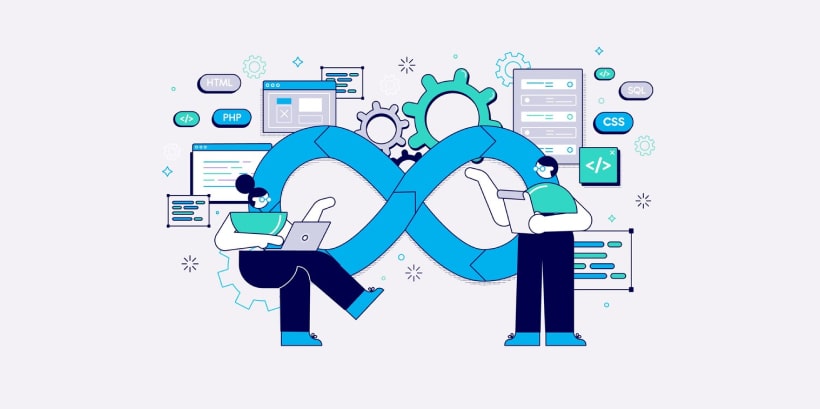The Evolution of DevOps in Cloud Computing: Trends Shaping the Future
1 MIN READDevOps automation and DevOps in cloud computing is a rapidly evolving trend today. But what are they?
To break it down, DevOps is a methodology that integrates with development and operation teams to ensure seamless collaboration and streamline their daily activities. It looks into automation of monotonous tasks like testing, deployment, and infrastructure management. By doing so, DevOps can enhance efficiency, collaboration, and continuous delivery of software.
Now, what is cloud computing?

Cloud computing is the process through which we can access on-demand computer resources. This includes servers, storage, and software over the Internet, for efficient development, scalability, and flexibility.
Cloud computing is the process through which we can access on-demand computer resources. This includes servers, storage, and software over the Internet, for efficient development, scalability, and flexibility.
Keep reading to learn about the shifting trends of DevOps in cloud computing and how this trend shapes the future.
Table of Contents
ToggleDefining DevOps in Cloud Computing

In simple terms, DevOps in Cloud Computing is a practice that assists the development and operations team to automate and streamline software delivery processes. You can integrate DevOps software into your system by yourself, however, if you find this procedure complicated, consider connecting the best DevOps consulting services for successful customization and integration.
On this note, DevOps for cloud computing platforms like Google Cloud, AWS, and Azure integrates into your system to enable continuous integration and continuous delivery processes. Furthermore, DevOps tools like Infrastructure as Code, containers, and orchestration platforms like Kubernetes also play an important role.
These are pivotal for teams to rapidly develop, deploy, and scale applications. Unlike, traditional processes, these DevOps automation tools reduce manual labor, save time, and test applications at every stage of deployment to achieve perfection.
Thus, with evolving DevOps automation practices, the development and automation team deploys and scales applications in dynamic environment teams. This is a great measure to help improve collaboration, efficiency, and reliability while delivering top-notch results.
How DevOps in Cloud Computing Works?

Now that you have an idea about what is DevOps in cloud computing, let’s take you through how it works.
The points below will paint a simplified picture for you about the working of DevOps in cloud computing.
- Automation
DevOps in the cloud is a great way to automate monotonous tasks such as code testing, integration, and deployment with tools like Jenkins and GitLab. - Collaboration
DevOps in cloud computing is also a powerful way to bridge gaps between development and operation teams. They can work together on the same application and can check, alter, or refer to past activities and every change and version to app development process will get stored in the cloud.

- Feedback and Monitoring
Cloud services working with DevOps monitor the application development process closely and provide real-time feedback for smooth functioning. - Infrastructure as a Code
DevOps in cloud computing platforms like Terraform manages Infrastructure as Code and ensures automation of cloud resource management.

- Continuous Integration
Through Continuous Integration, application developers consistently merge codes into a shared memory or repository to ensure automated testing. - Continuous Delivery
After testing, Continuous Delivery processes automatically deploy the successfully tested codes to production environments.

Evolution of DevOps in Cloud Computing
The evolution of DevOps in Cloud Computing began with traditional IT operations marking a transformative journey. The points below will take you to the evolution stages of software development and processes with time.

Traditional IT Operation or Pre-Cloud Era
Before delving into the world of DevOps in cloud computing, traditional IT operations dominated the landscape. Siloed teams, manual operations, and inefficient and slow development cycles were some of the major problems of this period. The urge to overcome these shortcomings led the world to transition and embrace cloud computing practices.
Early Computer Clouding

To mark the transition from traditional IT operations to cloud computing and DevOps, several cloud platforms started to gain popularity. Some of these popular platforms that led to the onset of the early cloud computing period are Azure, AWS, and GCP.
This period also introduced Infrastructure as a Service and brought to the limelight virtualized infrastructure and on-demand scalability. These new platforms also opened up the scope for faster provisioning and management through automation as DevOps automation practices.
DevOps Principle
The importance of DevOps automation tools heightened in the mid-2000s period. During this time, DevOps in the Cloud was growing popular with CI/CD pipelines and automation. These play a pivotal role in continuously integrating, testing, and deployment. At such times, DevOps tools like Jenkins, Terraform, and Ansible emerge to automate infrastructure and deployment.
Cloud Native DevOps

This is another crucial period that you must make note of while considering the evolution of DevOps in Cloud Computing.
The onset of the 2010 era witnessed the rise of micro services and container orchestration platforms like Docker, Kubernetes, and similar cloud-native development platforms. These platforms are a great solution to help you independently deploy and scale services with better accuracy.
Infrastructure as Code or IaC
As the evolution of DevOps in Cloud Computing moved forward, IaC started to rise towards the zenith of popularity. Users also embraced tools like Cloud Formation and Terraform to improve instances of automation of monotonous work and reduce manual labor with Infrastructure as Code.
Serverless Computing

Another important achievement of DevOps in Cloud is serverless computing which took over the digital landscape during the later part of the previous decade. Serverless computing systems example AWS Lambda let developers focus on writing code without managing the infrastructure. To ensure this, the cloud platform handles scaling and resource management.
AI and Automation
As we moved into the 2020s, DevOps in Cloud Computing witnessed a new integration with AI/ML. This new digital landscape known as AIOps introduced us to proactive monitoring, predictive analytics, and automation of processes which also reduced automation overhead. Besides this, NoOps also started to dominate the market to enable complete automation of domestic tasks.
Edge Computing and Hybrid Environments

Edge Computing practices expands the scope of DevOps in Computing to distributed environments. Furthermore, hybrid and multi-cloud methods are also crucial for the DevOps team to manage workflow across diverse platforms.
DevSecOps and Cloud Security
As DevOps in cloud computing evolves and the digital world calls dibs for the driving seat of technology advancement and the future, the security of sensitive data gains importance. The rise of DevSecOps marks the integration of security practices at every stage of application development and deployment. Today, implementing DevSecOps tools in the CI/CD pipeline is crucial for automated security testing, policy enforcement, and vulnerability scanning.
Furthermore, Cloud providers also offer integrated security tools. This includes Azure Security Centre, Google Cloud Security Command Centre, and AWS Shield. They are pivotal tools to enforce top-notch security practices within DevOps workflow.
GitOps and Future Trends

The advancement of IaC and DevOps in Cloud Computing brings to the table a relatively new trend of GitOps. As a future of DevOps, GitOps utilizes Git as the sole source of information for both application and infrastructure development. Utilizing this platform, organizations can focus on managing their entire system through automation of deployments and version control. This is essential whenever there is a change in repository.
Bottom Line
To conclude, DevOps in cloud computing and its rapidly evolving trends have introduced automation, security, reliability, and scalability to the mainstream process of software development.
It is an essential solution in today’s fast-paced digital world to enhance collaboration, ensure accuracy, and drive deployments faster.
To know how DevOps in clouds is the best solution for your business to achieve its goals faster connect with our DevOps experts.
Frequently Asked Questions
DevOps in cloud computing integrates with development and operational teams to automate functions like testing, code deployment, and infrastructural management with the help of cloud services like AWS.
Faster delivery, cost efficiency for using on-demand resources, automated deployment processes, better monitoring, and feedback loop are some key benefits for DevOps in cloud computing.
Microsoft Azure, Amazon Web Services (AWS) and Google Cloud platforms are common providers of DevOps in cloud computing.
Table of Contents
ToggleContact Us
